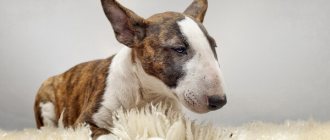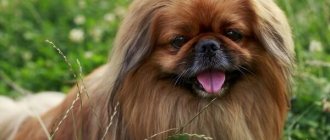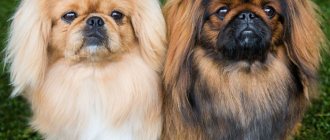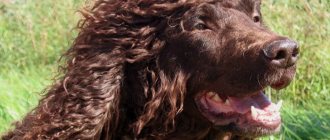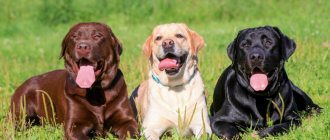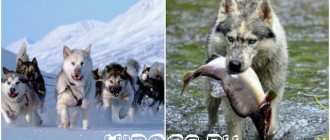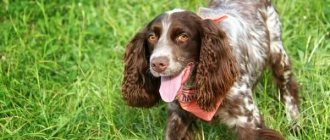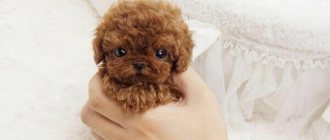Pekingese are one of the oldest dog breeds on Earth, whose history goes back thousands of years. These balanced, friendly dogs will be excellent companions for owners of small apartments who prefer to relax on the sofa instead of active recreation.
Let's find out what the owner of a Chinese dog should know so that the pet lives a long time and does not cause much trouble.
Origin story and what it looks like in the photo
Pekingese are dogs originally from China, which were bred by crossing representatives of the ancient Chinese decorative breed “Toy” with larger dogs.
Only representatives of the upper class were allowed to keep them, so the Pekingese always lived only in palaces and had personal servants.
Representatives of this breed have never been guards, watchmen or hunters. Their main purpose was to please and amuse their owners, and in temples they were worshiped as deities and considered a symbol of prosperity and happiness.
The coup d'etat in China had a negative impact on the Pekingese population - the rebels burned the imperial mansions to the ground, and the representatives of the breed who lived in them died. The British military managed to rescue several dogs and transport them to Europe.
In England, Pekingese quickly gained popularity, but they still remained dogs that were not accessible to everyone - the price of puppies was too high for ordinary people.
The breed acquired its official name only at the end of the 19th century, simultaneously with its recognition by dog handlers.
It should be understood that Royal Pekingese are not a separate breed . This is how breeders call individuals who ideally meet the standard, which, by the way, does not strictly regulate the height and minimum weight of adult dogs, but only describes the average acceptable indicators.
Puppies
From the very first days of a puppy of this breed in a new home, you need to provide him with bowls for food and water, toys, a leash with a collar, a tray and a sleeping place. In addition, it is better to immediately teach your baby to go to the toilet in a tray, and not to pick up various objects while walking.
It is important! You should not buy too many toys for your puppy - two or three squeakers will be enough. It is advisable not to buy balls for a dog of this breed, since due to the special structure of his jaws, he simply will not be able to grab them.
It is advisable to place the puppy's bed in a corner away from heating devices and drafts, but in such a way that the owner is always in the baby's field of vision.
Pekingese puppies have a fluffier and softer coat, which changes to an adult coat over time. Its change usually occurs at 4–8 months. During this period, it is enough to carefully comb the puppy with a massage brush every day, and the feathers on the legs and ears with a comb with sparse teeth.
In the first months of life, puppies need to be fed 6 times a day, gradually reducing the number of meals to two as they age.
This is interesting! In Ancient China, court dog handlers recommended feeding Pekingese with quail liver pate and a decoction of shark fins.
Pekingese weight and height chart by month
A newborn Pekingese puppy usually weighs 150–200 grams, and by the end of the first month of life it already weighs 400–700 grams. Representatives of the breed usually reach “adult” sizes by 9–12 months. A table of Pekingese height and weight by month in the first year of his life will help not only to assess the baby’s development, but also to understand what weight the pet will have as an adult.
This is interesting! At 4 months, the baby Pekingese's weight is approximately half of its "adult" weight.
| Age, months | Weight, kg | Height, cm |
| 2 | 0,8–1,2 | 10–12 |
| 3 | 1,3–2 | 11–15 |
| 4 | 1,8–3,1 | 13–17 |
| 6 | 2,6–4,2 | 17–20 |
| 7 | 3–5 | 20–22 |
| 10–12 | 3,2–5,5 | 20–25 |
Description of the breed
Royal Pekingese are a decorative breed of dog, not intended to perform working functions.
To meet the requirements of the standard, representatives of this breed must have:
- flat back, narrowed lower back and slightly slanted shoulder blades;
- muscular, well-defined withers;
- short and massive paws;
- wide and short muzzle with skin folds in the nose area;
- a high-set tail, which should be pressed to the back and slightly curved to the side;
- small heart-shaped ears that seem to droop due to the thick fur covering them;
- large, slightly protruding eyes with brown irises.
The coat is long and thick, the undercoat is dense . The quality and length of wool is influenced by the breeding and nutrition conditions of dogs.
Coat
The coat is long, lush, straight, slightly raised by a thick undercoat. It is shorter on the muzzle and on the outer sides of the legs.
The color is quite varied: red and red, black and white (with the exception of albinos), sand, “chinchilla”, which can be with or without a black mask. With a white color, it is desirable that the spots are located symmetrically on the head.
Character traits
Pekingese are proud dogs, accustomed to special treatment and the fact that the whole world revolves around them. This is exactly the kind of attitude they expect from their owners.
From the very first days of their appearance in the house, these dogs establish contact and a close emotional connection with their owner, which determines their ability to capture a person’s mood and sense changes in him.
Representatives of this breed are characterized by calm, measured behavior; although they are attached to their owner, they are not inclined to impose their company and tolerate loneliness without problems, since they are quite independent.
However, this does not mean that Pekingese do not need attention. On the contrary, if there is a lack of it, the pet’s behavior may change for the worse, and aggression is possible, especially towards the one who receives more attention from the owner.
Representatives of this breed are smart, so they quickly remember how they can or cannot behave, but natural stubbornness can seriously complicate the training process, so the owner will need maximum patience, endurance and perseverance.
Expert opinion
Kozhevin Semyon Kirillovich
Expert dog handler.
Royal Pekingese are true imperial dogs. They are used to being idolized and treated with all honors and do not tolerate disdain. These dogs cannot stand noise and scandals, they need peace and tranquility, so they are ideal as a pet for elderly couples. They tolerate short-term loneliness well, but if the owner is not around for more than a few hours, they begin to feel sad and melancholy, which can lead to a complete refusal of water, food, and even their favorite treats.
Dog training
Problems with raising and training Pekingese are extremely rare. The owner is advised to be patient.
The breed is characterized by stubbornness, which can get in the way of learning.
The easiest way is to use the services of a professional trainer. It is recommended to contact him within two months after birth. In this case, you will be able to achieve results quickly and secure them for life.
The Pekingese is an independent creature that does not tolerate being treated as a funny toy.
Advantages and disadvantages
It is generally accepted that representatives of decorative breeds, including Pekingese, are suitable for almost everyone. However, this is not entirely true, therefore, when thinking about purchasing a Royal Pekingese, you should familiarize yourself with the advantages and disadvantages of these dogs in advance.
The advantages of the Royal Pekingese include::
- unusual, attractive appearance;
- devotion;
- ability to withstand cold;
- fairly good health;
- possibility of apartment maintenance;
- calm character;
- no need for long walks and physical activity;
- unpretentiousness in food.
Among the disadvantages of the breed are noted:
- stubbornness and willfulness;
- jealousy;
- excessive independence;
- snoring and sniffling;
- heat intolerance;
- need for attention.
In addition, Pekingese require careful grooming and are characterized by heavy seasonal shedding.
Nuances to consider when purchasing
The answer to the question of how much a Pekingese costs depends on several factors. Among them:
- Gender. Boys look more impressive;
- Genetic predisposition. Before purchasing, it is recommended to “get to know” his parents;
- Quality of animal care before sale;
- Puppy class (show class, pet or breed);
- Breed temperament.
The average cost of a future champion in a domestic nursery varies from 20 to 30 thousand rubles.
It is not recommended to buy a puppy based on a photograph. If there is no other opportunity to see your pet, you should discuss its return in advance.
Is he good with children and does he get along with other pets?
Royal Pekingese do not have a hunting instinct, so they can get along well with cats, rodents and birds, but only on the condition that they still receive the main attention of the owner, and not someone else.
Relationships with other dogs are more difficult.
The fact is that Pekingese have a pronounced Napoleon complex, which does not allow them to build friendly relationships with other dogs.
Pekingese are unlikely to be able to make friends with children - representatives of this breed are sensitive to pain and are not characterized by special patience. In addition, these dogs do not like the noise and fuss that accompany children's games.
Of course, they can get along with school-age children, but the child must respect the dog and not claim its personal territory or toys.
Dwarf (sleeve) Pekingese
To receive this title and become a representative of the breed elite, the Pekingese must weigh no more than 3.2 kg. The remaining characteristics of the behavior and character of these babies are fully consistent with standard Pekingese dogs.
As a rule, this companion dog is in good health, has a strong, well-developed bone structure, a proportionally built body, and a sedate gait characteristic of the breed. The shape of the muzzle, head, eyes, ears and nose - all this repeats the description of the animal of the standard (royal) Pekingese breed.
In the case where the low weight of an animal is due to underdevelopment, a weak skeleton, or a fragile physique, then such an individual is not recognized as a dwarf. And once again we would like to warn you that dwarf Toy Pekingese, mini Pekingese, etc. do not exist in nature as a separate breed. These very funny and cheerful babies, appearing quite rarely in the litter, are very popular, but this is just a breeding marriage of standard Pekingese.
Dwarf Pekingese puppies have noticeable imbalances in body proportions: their heads are too large, their spine is often curved, and their bones are thin. Often these dogs have genetic diseases that affect their life expectancy. They are not long-lived, and they are many times more expensive than a regular (royal) Pekingese. Experts consider the appearance of such babies to be a sign of degeneration of the breed.
How to properly care
Royal Pekingese are not too demanding to care for; the owner's main efforts should be aimed at caring for the coat of these dogs.
Wool and bathing
The coat should be combed daily using a massage comb, a slicker brush and a furminator. The coat requires especially careful combing during shedding.
NOTE!
You should bathe your pet using special shampoos and conditioners for long-haired dogs a maximum of once a month, unless it gets very dirty.
If the pet does not participate in exhibitions, it can be trimmed, giving it more individuality and making it easier to care for its coat.
Claws
Trim the nails with a guillotine nail clipper once every 3-4 weeks, smoothing the sharp edge with a nail file.
Eyes
Wipe daily with a cotton pad soaked in chamomile infusion, tea leaves or warm boiled water.
Teeth
Brush weekly using a special paste and brush - this will help avoid the formation of plaque.
Ears
Inspect and clean from sulfur and dirt by wiping with a cotton pad soaked in hydrogen peroxide or a special product at least once a week.
There is a risk of damaging the eardrum when using cotton swabs.
Life expectancy, health and major diseases
On average, Royal Pekingese live 12-15 years, with some individuals known to live up to 20 years.
Most often, representatives of this breed are diagnosed with:
- problems with the spine;
- urolithiasis;
- skin and cardiovascular diseases;
- cataract;
- conjunctivitis;
- inflammation of the tear ducts;
- renal failure;
- hydrocephalus.
In addition, Pekingese are dogs with a brachycephalic skull structure, which causes breathing problems, especially in the heat and in case of excessive physical exertion.
Learning ability
The Pekingese dog is prone to dominant behavior; it constantly looks for weaknesses in the owner’s behavior in order to take a dominant position. It is not easy to train a Pekingese - he is stubborn and persistent. You need to start training at an early age with everyday commands: “Fu”, “Come to me”, “Sit”, “Lie down”, “Near”, “Place”. You should first accustom your pet to a leash. You need to prepare your dog for exhibitions from the age of two months.
Pekingese training rules:
- Exercise at a certain time - the dog appreciates the routine.
- Don't start training with a well-fed dog.
- Don't rush into mastering commands. Secure one, and only then proceed to the next one.
- Start in a calm environment, then introduce complications and stimuli.
- Insist on following this command and sincerely praise the dog for its work.
Pekingese: breed description, appearance
Nutritional Features
The choice of food type depends on the owner . These can be natural products or ready-made dry food - the main thing is that the diet is balanced.
The advantage of natural feeding is the ability to choose products for your pet and control their quality. In addition, nutrients of natural origin are better absorbed by the dog’s body.
Royal Pekingese should be included in the menu:
- offal;
- lean meat;
- cereals;
- fruits, herbs and vegetables;
- sea fish;
- dairy and fermented milk products.
It is forbidden to feed representatives of this breed:
- bones;
- sweets;
- fatty meat;
- legumes;
- fried, smoked, salted, spicy and pickled foods;
- exotic fruits;
- baked goods;
- pasta.
IMPORTANT!
Additionally, you should give your pet a complex of vitamins and minerals.
Dry food is more convenient to use and store, and also does not require additional intake of a vitamin-mineral complex. You should choose food from products of at least premium class, taking into account the age, health and physiological state of the pet.
The most suitable food for Royal Pekingese: Happy Dog, Acana, Artemis, Almo Nature, Canidae, Orijen, 1st Choice, Royal Canin, Arden Grange, Brit Premium.
Feeding
The Pekingese is a naturally healthy animal. Therefore, by offering him a competent diet, you will maintain your friend’s good health for many years. It is necessary to completely exclude smoked meats, milk, white bread, sweets, sausage, and pork from the diet.
The diet of an adult animal should consist of 1/3 of lean raw meat and fish. The menu will be complemented by cottage cheese, kefir, and vegetables. As a treat, you can use fruit and just a little honey. Chicken and offal should only be given to dogs in boiled form.
How to choose?
When choosing a puppy, you should first make sure of its health . So, if your future pet has a rash or irritation on the skin, there is increased lacrimation, there is an unpleasant smell from the ears and there is discharge from the nose, most likely these are symptoms of some pathology.
In addition, it is important to examine the baby for compliance with the breed standard and check with the breeder about the availability of vaccinations, as well as all the necessary documents confirming, among other things, the purebred of the puppy.
Bitches and males have virtually no differences in character, except that boys can be more assertive and straightforward . But there are external differences: the coat of males is thicker and more lush, because females undergo additional shedding after childbirth and estrus.
Mating
Pekingese reach sexual maturity at 7-10 months , but it is recommended to breed only at the 20th month of life. Then the Bitch will begin her third heat. Otherwise, she will not be able to bear, and most importantly, give birth to a puppy, because these dogs have a fairly large head. Doctors often resort to caesarean section.
Before mating, both dogs must be examined for pathologies, checked for diseases and cleaned of internal and external parasites. The girl should show primary signs of readiness: light spotting, swelling of the loop and playful behavior.
The girl is brought to the dog’s territory, the animals are given 10-15 minutes to sniff and get to know each other. If everything went well, the female will allow the cage to be mounted. Usually the act lasts 5-7 minutes , and the lock - 15-20 . At this time, the bitch is supported under the belly and is not allowed to sit down, and the dog is sent into the noose. Repeated mating is carried out after 2 days.


